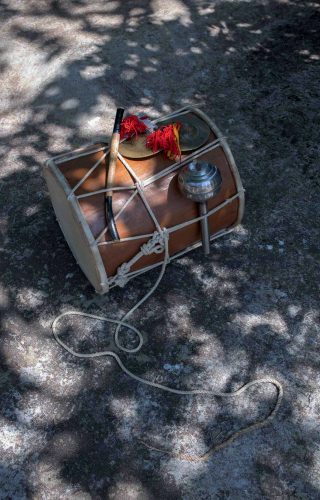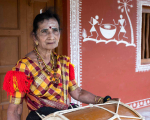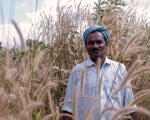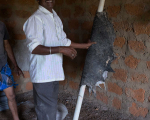‘Dollu Kunitha is not fashionable. Only girls who are passionate or seek to do something different for themselves will pick up Dollu,’ says Sri Choodamani Ramachandra, the first woman artist to perform and teach Dollu Kunitha, a popular folk dance form in Karnataka.
Karnataka is home to many folk dance forms and performance arts associated with Hindu temple rituals and folklore of indigenous castes and communities, collectively referred to as Aradhane Kalegalu. Dollu Kunitha is one such dance form. It is performed before every temple ritual in northern Karnataka. I witnessed a Dollu Kunitha performance during the Karaga festival at Sri Dharmaraya Swamy Temple in Bangalore for the first time. Just as the festival was picking up energy, the crowd parted, and a group of young men with bare upper bodies walked in carrying huge drums. They put up an intense display of rhythmic drumming and orchestrated dance movements in honour of Draupadi, wife of the Pandavas.
Dollu Kunitha involves beating the dollu—a double-headed percussion instrument native to Karnataka. The dance form has its origins in mythology about a demon named Dollasura, who was an ardent devotee of Lord Shiva. Pleased with his devotion, Shiva appeared before the demon and granted him a boon. In his arrogance, Dollasura wished to swallow Lord Shiva or be granted the power of immortality. His boons were rejected. Enraged, he swallowed Lord Shiva in anger. Shiva expanded himself inside the body of Dollasura, bursting his stomach and killing him. He then made dollu from the skin of Dollasura and gifted it to his ardent devotees, the Kurubas. The Kurubas created Dollu Kunitha in honour of Beeralingeswara (a form of Lord Shiva), using the drum gifted by Lord Shiva.
In Karnataka, Dollu Kunitha was passed down through generations of Kurubas. The Kurubas were traditionally shepherds and practised transhumance pastoralism in the Deccan with their domestic livestock of sheep, goats and cattle. Their name is derived from ‘kuri’, meaning sheep. Since the dance is reliant on sheer strength, stamina and muscle power, historically it was performed by Kuruba men and taught only by male teachers. When I read a news article about a septuagenarian lady—Sri Choodamani Ramachandra—performing and teaching Dollu Kunitha, I was curious to know more about her story.
Choodamani Ramachandra was born in a small town close to Sagara, in the Shivamogga district. She had grown up watching Dollu Kunitha and was deeply drawn to it. But as a woman, she couldn’t learn it or perform it. She was keen to play the dollu as she had always been a strong believer that there is nothing women cannot do or learn. At the time, senior teachers were reluctant to train her, saying it was against tradition and that women can’t handle the physical rigour. Not one to take no for an answer, Choodamani persisted in her search for a tutor. She finally met Ramappa, a dollu performer with a local group who performed at temples during festivals. Rampappa, glad for the opportunity to attempt something different, agreed to teach Choodamani and her group of mostly middle-aged women.
In India, which has strict caste boundaries, it is no surprise Choodamani faced resistance from the community and from neighbours. Many, including her mother, were shocked at the idea of an upper-caste Brahmin woman touching and playing the dollu, which is made from the skin of a dead animal. However, she received encouragement and support from her husband, Ramachandra, to pursue her passion. Some days, to save money, they would walk miles to Ramappa’s village for practice. Since none of the troupe members owned the instrument, they would rent dollus for Rs. 100 a day. Due to limitations of space and having to take time away from family duties, it took them almost two years of practice to master the dance.
After two years, she established her troupe, Snehasagara Mahila Mandala, which now consist of a dozen women artists. They started performing in their town during local festivals and during Karnataka Rajyotsava Day. Snehasagara Mahila Mandala has performed in India, Thailand, China and many other countries. Sometimes, due to budget constraints, there were trips that Choodamani had to plan with a smaller group or even travel alone. When I asked her about the reaction of the audience in foreign countries, she told me, ‘Dollu has no language barrier, everyone understands rhythm in their heart.’
Today, there are several all-women Dollu Kunitha troupes, thanks to Choodamani’s relentless efforts. It has not been an easy path for her or other women Dollu artists. While criticism from the community has slowly made way for admiration, performance art is still male-dominated. Women within the Kuruba community are not encouraged to learn and perform. Dollu artists from across the state assemble at the Adira male Habba, an annual festival at the 800-year-old Kumara Raman Temple in Thalaguppa village. But this performing space remains closed to women.
People I met in Sagara narrated stories of how, over the years, Choodamani worked tirelessly to open ensure more opportunities for women, from giving driving lessons to arranging free education to teaching dance lessons, the list was endless. She is also a folklorist, dedicated to the preservation of Karnataka’s intangible heritage and oral traditions. During the nationwide lockdown due to the COVID-19 pandemic, she spent her spare time researching the Kannada Janapada Viswakoota, an encyclopedia of all folk art forms of Karnataka, of which there are many specific to women, like harvest songs, lavani (song and dance), hasechittra (traditional wall art), bhoomanni butti kale (the art of weaving a special basket), etc. Yet, Choodamani observes, there is not enough mention of women in the book. She wants to write a book in Kannada that documents the missing folk forms. She tells me, ‘The beauty of Janapada (folklore) is it can be what we want it to be, and it belongs to whoever practices it. It has space to innovate and change with the times, as opposed to classical art forms, which are more hierarchal and encoded. The emotion evoked in folk performances is universal, that goes beyond constraints of any community.’
The pandemic halted all Dollu Kunitha performances, and in the course of making this story, I missed the electric energy of live performances with a cheering audience, but to see Choodamani at her home added a different perspective to my understanding of the dynamics and challenges women face in the interiors of India where caste, social attitudes and gender are significant barriers for women to overcome. Through the pandemic, she has been in touch with her students and helps them out in whatever way she can. Choodamani hopes the government will extend some financial support to artists who rely on performances for their livelihood. Though times are difficult, she is looking forward to a future when the beat of dollus will be heard again.
This photo-essay has been created as part of the Sahapedia Frames Photography Grant, supported by CSR funding from IndusInd Bank.
















